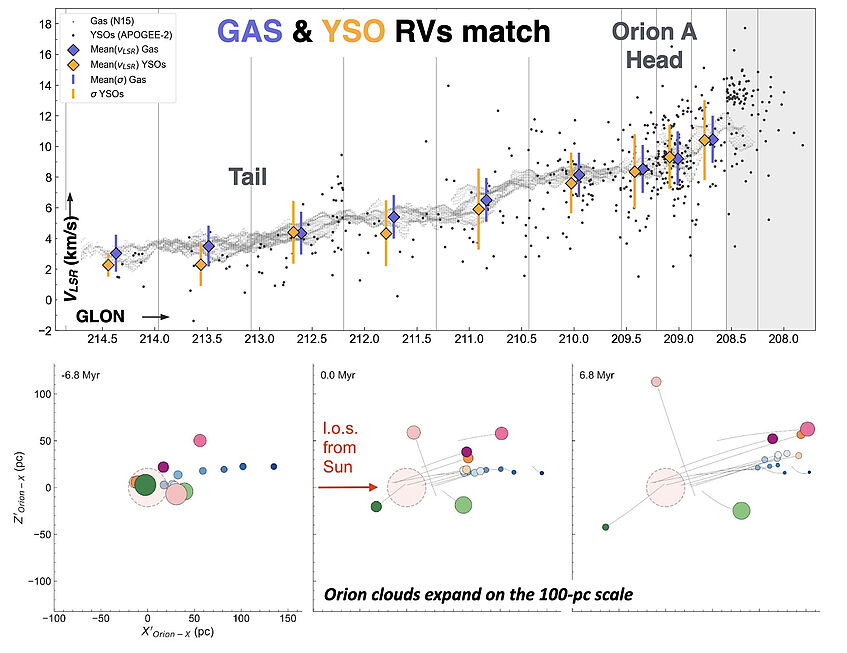The Orion Molecular Clouds are Expanding on the 100-pc scale
3D dynamics of the Orion molecular cloud complex. Discovery of coherent radial gas motions on the 100-pc scale
We were able to reconstruct the 3D structure and dynamics of the Southern Orion molecular cloud complex, the closest massive star-forming region to Earth (d~300-500pc). To achieve this, we combined Gaia parallaxes and proper motions of recently formed young stars (Großschedl+2019) with stellar and gas radial velocities (RVs). Young Stellar Objects (YSOs) with IR excess are good probes for 3D cloud shape and motion since they are still close to their birth sites and they still share on average the same RVs as the gas (see Fig. 1).
The 3D investigations of the Orion molecular cloud complex allowed for the first 6D phase space analysis of the interstellar medium (ISM), including the molecular clouds Orion A & B, and three cometary-shaped outlying clouds. We find that the cloud parts are expanding on the 100-pc scale (see Fig. 1), which we attribute to feedback from massive stars (e.g., supernovae, SNe) that originated from older clusters in the region.
Such feedback was able to transfer momentum to the clouds before they formed the stars. Based on a dynamical traceback this happened about 6 Myr ago (see 3D-vis-Orion). This analysis therefore allowed for the first momentum analysis of molecular clouds (cloud masses calculated with ESA Herschel).
We were able to quantify of the momenta by comparing them to simulations (e.g., Walch & Naab 2015). We find that more than one SN is needed to explain the observed cloud expansion in Orion. Our findings added new information to the long-standing paradigm of propagated/sequential star formation (Elmegreen & Lada 1977) and they also fit formation scenarios of the Orion-Eridanus superbubble, which is a bubble of hot gas surrounding the whole region with a radius of about 160 pc (e.g., Ochsendorf et al. 2015).
The identification of molecular cloud expansion within the Orion region supports the understanding that these regions are dynamic and evolve over time, while additional feedback forces are likely needed to explain the large-scale expansion in Orion. The utilization of Gaia data and YSOs as tracers demonstrates a novel, successful approach to studying the 3D dynamics of molecular clouds and their interactions with young stars, and could serve as a model for studying similar phenomena in other star-forming regions.
Our findings have laid a solid foundation for future analysis, opening a new "3D window" on the formation of dense clouds and stars. The discovery of molecular cloud expansion in the Orion region provides new insights into the mechanisms governing star formation and molecular cloud evolution. Our research has the potential to contribute to the broader field of astrophysics by enhancing our understanding of the interplay between young stars and their birth environments. Moreover, it enables us to quantify massive stellar feedback, the most important unknown in state-of-the-art cosmological simulations of galaxy formation and evolution.

Fig. 1. The Orion molecular cloud complex is expanding on the 100-pc scale (Großschedl et al. 2021). Top: Position-Velocity diagram for the Orion A giant molecular cloud. The gas radial velocities (RV) (gray dots and blue diamonds, 12CO, Nishimura eet al. 2015) match on average very well with the YSO RVs (black dots and orange diamonds, APOGEE-2). Both show a velocity gradient from head to tail (from the massive Orion Nebula Cluster region to the low-mass star-forming tail, L1641). This leads to the conclusion that YSO proper motions from Gaia also trace the cloud proper motions. Bottom: 3D space motions of molecular clouds in Orion. Side-view at three time-steps. Shown are cartesian average positions of cloud parts, centered on the cluster Orion-X (red circle, as rest frame, possible progenitor cluster for feedback from massive stars). Cloud parts are shown for Orion A (blue), Orion B (magenta), and two cometary shaped outlying clouds (green). Additionally, the two young clusters σ Ori and NGC1977 are shown (orange). The cloud parts and/or young clusters were closest in space about 6 Myr ago and show an expanding motion on the 100-pc scale indicating the influence of feedback from massive stars in the past. See also the link to the interactive figure, 3D-vis-Orion.
